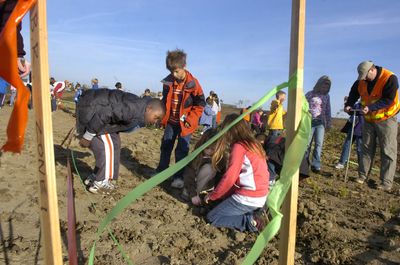Kids fill wetland with new plants
Moran Prairie students help on county project

It’s not every day you find prairie dogs in a marsh.
But there were nearly 400 of them Tuesday in the Ben Burr wetland project near Moran Prairie Elementary School.
As their mascot does in the drylands throughout the West, the Moran Prairie first- through sixth-graders were digging in the dirt, returning to school with dusty shoes, dirty knees and muddy hands.
Wave after wave of the South Hill kids walked the two blocks from their school near the intersection of 57th Avenue and the Old Palouse Highway to assist biologists and landscapers by planting 6,000 bulrushes, sedges and cattails to enhance eight acres where water already pools. The work was part of a Spokane County project to create wetlands to collect and filter runoff in an area where houses and pavement interfere with natural drainages. Much of the water comes from nearby Browne Mountain.
The first prairie dogs to arrive Tuesday morning were third-graders from Ms. Moore’s and Ms. Brown’s classes. Before they could leave, the next wave showed up – second- and fourth-graders, followed by first- and fifth-graders who worked together as buddies, and so on throughout the sunny day.
Every group was given a color-coded bucket of seedlings and directed to a portion of the future wetland where each plant will thrive – cattails in areas that will have water most of the time, sedges in places that are slightly drier. Each plant went into a hole bored into the hard earth by workers with jackhammers and drills.
“Hold up, guys,” Lyle Dach, who was supervising the work for contractor EarthStone Developments, told a group planting seedlings from a yellow bucket in an area marked with pink surveying tape. “I’m going to need you to pull those up.”
If all goes as planned, the seedlings tamped into holes on Tuesday will be well established in a few years, and fully grown into a natural marsh about the time fifth-grader Anne Arbanas is graduating from high school. She looks forward to seeing the critters that eventually will be drawn to the newly created habitat.
“Ducks and maybe some deer,” she said, helping a first-grader place a sedge into a hole near a sure-enough whitetail track. “You might see a rabbit” as well as frogs and toads, “and a lot of insects,” Arbanas said.
Right now, it’s brown that there’s a lot of. The immature plants are widely spaced and unnatural-looking, like hair plugs on an otherwise bald head. But fifth-grader Bria Bowton knows the spaces will fill in, creating a place for all that suburban wildlife Arbanas anticipates.
“I think it will be really fun to come back every week or so and watch them grow,” Bowton said.